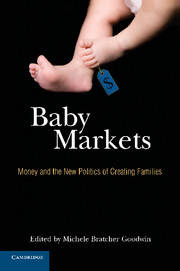Book contents
- Frontmatter
- Contents
- Preface
- Acknowledgments
- Introduction
- PART ONE WHAT MAKES A MARKET? EFFICIENCY, ACCOUNTABILITY, AND RELIABILITY OR GETTING THE BABIES WE WANT
- PART TWO SPACE AND PLACE: REPRODUCING AND REFRAMING SOCIAL NORMS OF RACE, CLASS, GENDER, AND OTHERNESS
- PART THREE SPECTRUMS AND DISCOURSES: RIGHTS, REGULATIONS, AND CHOICE
- PART FOUR THE ETHICS OF BABY AND EMBRYO MARKETS
- PART FIVE TENUOUS GROUNDS AND BABY TABOOS
- 18 Risky Exchanges
- 19 Giving In to Baby Markets
- Concluding Thoughts
- Author Bios
- Index
Concluding Thoughts
Published online by Cambridge University Press: 05 August 2012
- Frontmatter
- Contents
- Preface
- Acknowledgments
- Introduction
- PART ONE WHAT MAKES A MARKET? EFFICIENCY, ACCOUNTABILITY, AND RELIABILITY OR GETTING THE BABIES WE WANT
- PART TWO SPACE AND PLACE: REPRODUCING AND REFRAMING SOCIAL NORMS OF RACE, CLASS, GENDER, AND OTHERNESS
- PART THREE SPECTRUMS AND DISCOURSES: RIGHTS, REGULATIONS, AND CHOICE
- PART FOUR THE ETHICS OF BABY AND EMBRYO MARKETS
- PART FIVE TENUOUS GROUNDS AND BABY TABOOS
- 18 Risky Exchanges
- 19 Giving In to Baby Markets
- Concluding Thoughts
- Author Bios
- Index
Summary
Baby Markets is published at a pivotal time; a year after Nadya Suleman's controversial birth of octuplets, shortly after President Barack Obama lifted federal restrictions on stem cell research, and in the midst of nations changing their adoption laws as a response to allegations of child trafficking and selling. These issues inform us of the urgency for an international discourse on creating families. Implicated in all of this are the ways in which markets have come to dominate how children come into families. As we have learned, markets can help families overcome discrimination. Gay couples suffer from the laws of nature in their inability to naturally reproduce within a couple, which is exacerbated by state laws that limit their ability to adopt. The laws of infertility do not help couples, passionate to parent, who learn that their bodies cannot help their dreams come true. Markets help these couples achieve their dreams. Often, children are benefited by their decisions, but sometimes not.
The lengths to which men and women venture to acquire a child are at times heart-wrenching. Anecdotal accounts of couples surmounting the heaps of adoption papers, extensive reference checks, and home visits offer not only glimpses of the tangled bureaucratic side of adoption, but also reveal layers of inefficiency that affect children languishing in U.S. foster care systems. For too many children in foster care, waiting for a stable home to materialize is tantamount to waiting for the stork to arrive or the lottery to be won.
- Type
- Chapter
- Information
- Baby MarketsMoney and the New Politics of Creating Families, pp. 295 - 296Publisher: Cambridge University PressPrint publication year: 2010



